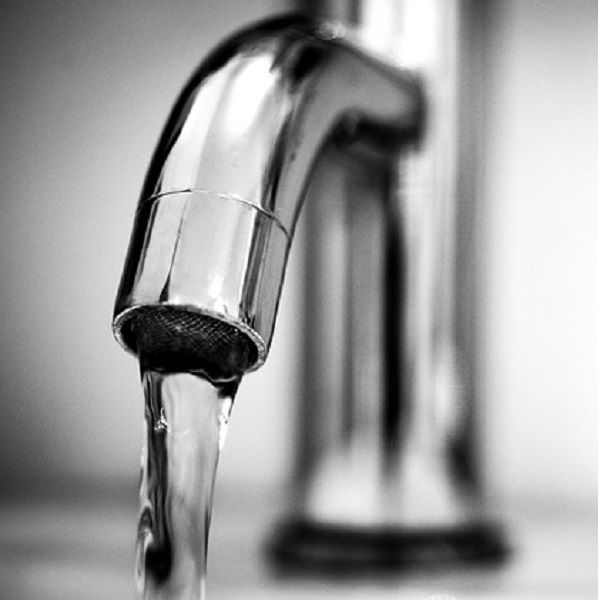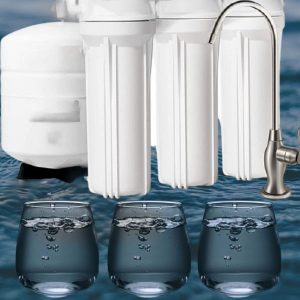Does Reverse Osmosis Remove Lead From Water?
The technology of a reverse osmosis filtration system is a simple yet genius technique to enhance water quality.
The process initiates the flow of water, progressing from a concentrated mixture (with more impurities) to a more dilute mixture (with lesser impurities) through a partially permeable RO membrane. This ensures the removal of common chemicals, including lead.
Pre and post-filters are present to increase the effectiveness of the reverse osmosis system
So, to answer the question, “Does reverse osmosis remove lead?”, yes. Reverse osmosis systems lower the lead levels in the water quite remarkably, which enhances the water quality.
Impact of Lead on Our Body
Lead is among the heavy metals found in the earth’s crust which is harmful to a healthy human body regardless of the amount consumed. Organic lead poses a significant risk since it builds up inside our bodies even when taken in small amounts. High levels of exposure to lead may cause lead poisoning, which can cost you your life.
Lead is hazardous for children because their body is still in its development stage. It causes significant and permanent damage to the physical and mental health of children. Any damage to their brain or nervous system can have long-lasting ramifications.
Lead is also unsafe for pregnant women since it is known to cross the placental barrier. Mild exposure of lead to the unborn child has a high risk to the child’s nervous system and overall development. Long-term exposure can lead to stillbirths, miscarriages, or even infertility in both men and women.
Lead exposure can lead to many side effects, which may diminish your health. For example:
Short-term overexposure to lead may cause:
- Abdominal pain
- Constipation
- Loss of appetite
- Weakness
Side-Effects of Lead for Adults:
- Increased Blood pressure
- Joint ache and Muscular pain
- Headache
- Unexpected mood swings
Side-Effects of Lead for Children:
- Learning difficulty
- Development delay
- Loss of appetite
- Hearing loss
Due to these reasons, most of the newer pipes are made of copper. That does not mean that our drinking water is lead-free. There are lots of old pipes that are supplying contaminated water in our households. That is why you need an under-sink water filter in your home to get lead-free water.
How Does Reverse Osmosis Remove Lead?
To understand how reverse osmosis removes lead in the water, we must first learn what reverse osmosis is. In simple terms, as the name may suggest, a reverse osmosis filter system is the opposite of osmosis.
A reverse osmosis system is a simple water filter process that demineralizes a flow of water under high pressure through a partially permeable layer to obtain drinking water, also known as reverse osmosis water.
Unlike osmosis which occurs naturally without the aid of external energy, reverse osmosis requires external energy. This energy propels the water through the partially permeable membrane, allowing the water molecules to pass through while preventing the flow of other harmful contaminants, including lead.
In an RO system, there is a pre-filter, a membrane, and a post-filter. When water that was contaminated by lead pipes passes through this system, it becomes free of impurities.

What Does Reverse Osmosis Filter Remove?
Reverse osmosis water treatment removes 99% of all chemical contaminants, including metal ions, aqueous salts, sodium, chlorine, copper, and chromium. Moreover, It also reduces fluoride, radium, sulfate, calcium, magnesium, potassium, and nitrate from the water. However, the RO system does not remove bacteria and viruses.
The partially permeable reverse osmosis membrane discards contaminants based on their molecular weight and charge.
In simple words, if a contaminant’s molecular weight is greater than 200, the reverse osmosis system will block its passage. For reference, the molecular weight of water is 18. Similarly, if the contaminant has a high positive or negative charge, the system will reject it.
Do All Reverse Osmosis Systems Extract Lead?
There are several types of reverse osmosis systems, each designed for a particular filter need, each having various sizes and applied pressures. Although they have different names, each and every reverse osmosis water processing regime serves the same purpose. They purify water and remove its contaminants.
All reverse osmosis systems have a high-pressure vessel and partially permeable membrane. It separates the concentrated solution from the dilute one. Some of them have pre and post-filters along with carbon filters, while some don’t. So, to answer the question— all reverse osmosis systems DO NOT extract lead. Therefore, you should do your research before buying a reverse osmosis system.
Examples of RO water filtration systems include:
- Desalination Systems: mainly used to extract salt from seawater.
- Brackish water systems: used to clean highly saline waters.
Problems With Reverse Osmosis
Although reverse osmosis water treatment is exceptional at filtering water, prolonged use of the system has disadvantages.
RO water treatment is highly inefficient and wastes a lot of water for the decontamination procedure. The amount of water it wastes is a whopping 20 gallons. In contrast, it produces only 1 gallon of pure quality drinking water.
The RO water filter eliminates substances based on their size/molecular weight and charge. Thus, its filtration procedure removes some of the beneficial minerals essential for the human body. This happens because of their large molecule size or charge. These valuable minerals include calcium and magnesium.
The partially permeable reverse osmosis membrane is prone to blockage and can quickly get clogged. This can slow down the decontamination procedure and the amount of water produced per day. This risks contamination and increases the maintenance cost of the system itself.
Other Water Filters That Filter the Lead In Water
RO treatment is the most commonly used and cheapest when it comes to removing lead in water. However, there are other ways to successfully achieve the same results aside from distillation. Other water filters also do a tremendous job filtering out almost 99% of lead from drinking water. These filters are:
Filter Pitchers
Regular filter pitchers have a simple design that is handy, portable, easy to use, and carry. It uses an ion exchange resin along with activated carbon, which is coconut-based which plays a vital role in the removal of lead from the water supply. This filter requires a WQA certification which proves that it is experimentally tested and removes 99% of lead.
Faucet Mount Unit Filter
There are ample amounts of faucet mount water filtration units you can acquire from the market. These activated carbon-based processing systems are incredibly unique.
They do not require any electricity and only rely on the water pressure of the main supply at the faucet. This system reduces lead levels and removes mercury, bacteria, chlorine, and other harmful contaminants.
Whole House Filters:
You can install these activated carbon filters in the pipes of the main water supply of a house. This treatment system works well with cold water and significantly reduces lead contamination in tap water.
Showerhead Filters:
These filters use a particular medium that strains out 99% of lead from the water supply. This water filtration unit is helpful because lead can be extremely harmful to your hair. Moreover, this lead can further penetrate your skull to cause permanent brain damage even in adulthood.
Conclusion
Having some sort of a filtration system should be an essential part of every household. Water impurities, including lead, can have severe and, in some cases, deadly effects on our bodies.
This is why we should always be safe and protect ourselves and our loved ones from these contaminants. Install a whole house RO system in your home to get an unlimited supply of lead-free drinking water.
